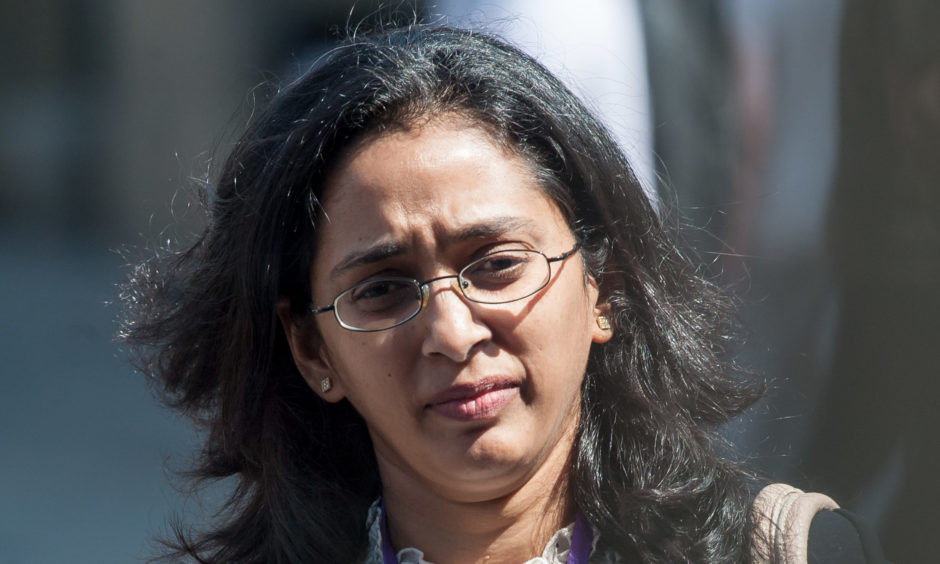A senior NHS gynaecologist caused an unborn baby to be accidentally decapitated inside her mother’s womb after failing to sufficiently weigh up the risks of the procedure.
Dr Vaishnavy Laxman, 43, should have given the 30-year old patient an emergency Caesarean section as the premature infant was in a breech position.
But she instead attempted to carry out the delivery naturally and tragedy struck when the doctor urged the patient to push whilst herself applying traction to the baby’s legs.
The manoevre caused the infant’s legs, arms and torso to become detached leaving the head still in his mother’s womb.
Two other doctors subsequently carried out a C-section on the woman to remove the infant’s head. It was ”re-attached” to his body so his mother could hold him before she said goodbye.
It is believed the child was already dead before he was decapitated during the bungled 15 minute delivery.
At the Medical Practitioners Tribunal Service in Manchester, consultant Laxman who qualified in Chennai, India, denied wrongdoing saying she believed the baby would have died had a caesarean section been carried out.
But at a finding of facts hearing panel chairman Tim Bradbury said: ”It was Dr Laxman’s decision in this regard that was to dictate her subsequent actions and the course of events which ultimately led to Baby B being decapitated.
‘Failed to address risks of vaginal delivery’
The Tribunal was in no doubt that throughout her involvement in the attempted delivery of Baby B, she was endeavouring to achieve the best outcome for Patient A and Baby B.
”However the central issue in this case is whether Dr Laxman’s decision to attempt a vaginal delivery of Baby B rather than an immediate caesarean section under general anaesthetic was clinically indicated or whether the only proper course in the circumstances would have been to proceed to an immediate caesarean section.
”Dr Laxman had not sufficiently addressed in her mind the risk to Baby B by proceeding with a vaginal delivery – namely the risk of head entrapment and the delay this complication would inevitably cause.
”Further, the Tribunal found that she embarked upon a vaginal delivery without a proper basis for concluding that a delivery was imminent or that there were any characteristics present that might be regarded as favourable to a vaginal delivery.
”The Tribunal did not accept that the circumstances were such that Dr Laxman should have assumed that a caesarean section would have no prospect of success.
”The Tribunal determined that at this time Dr Laxman’s priority was a live delivery and there was also a reasonable prospect that Baby B could have survived following an immediate caesarean section under general anaesthetic.
”The decision to proceed with vaginal delivery represented a failure in her clinical decision-making on the evidence available to her at the time.”
Vaishnavy Laxman: ‘We are not doing a C-section.’
The tragedy occurred on March 16 2014 whilst Laxman was working at Ninewells Hospital in Dundee with a team of other doctors.
The woman’s waters had broken early at 25 weeks and upon examination her unborn baby was found to have a prolapsed cord, was in a breech position whilst the mother’s cervix was between 2-4cm dilated. It can be 10cm fully dilated and the patient was told by doctors she might have to undergo a C-section.
Laxman had started work at 8.30am the previous day and went home at 6pm for five hours before returning to the hospital at 11pm. She was told about the patient at 2am and was subsequently paged at 8.30am to take a look at her when her condition became more critical.
Later whilst discussing the method of delivery, Laxman told a colleague: ”We are not doing a C-section – you would never do a C-section of a 25 weeker.”
She then carried out a vaginal examination of the woman and told her ”to push.”
‘Baby’s head became trapped in the uterus’
Mr Bradbury added: ”Initially the body of Baby B descended without difficulty however, the arms were raised and the hands were behind the head which required manipulation by Dr Laxman for their delivery.
”Thereafter, Baby B’s head became trapped in the uterus with his neck within Patient A’s cervix.
”There then followed what was to become, in the Tribunal’s view, an increasingly desperate attempt to deliver Baby B’s head. Because of the pain and distress that Patient A was by this time experiencing, the decision was made to administer a general anaesthetic following which further attempts were made to incise Patient A’s cervix and extract Baby B by means of traction.
”While Patient A was under general anaesthetic, Dr Laxman continued to make attempts to deliver Baby B by traction and ultimately Baby B’s head became detached from his body. The evidence suggests, and the Tribunal accepts, that by the time that Baby B’s head became detached from his body he had already died.
”Even on her own initial assessment that Patient A’s cervix was 4cm dilated this should have indicated to Dr Laxman that this was insufficient to deliver Baby B’s head.
‘Distraught at the outcome’
”She should have appreciated that there would be a real and significant risk of complications arising during delivery, namely head entrapment, having had regard to the likely diameter of the baby’s head at this gestation.
”Dr Laxman made a decision which was not clinically indicated, in that she failed to perform an immediate delivery by caesarean section under general anaesthetic and instead proceeded with a vaginal delivery.
”Her conduct set in train a course of events which ultimately resulted in the decapitation of Baby B and to this extent contributed to that decapitation. But for Dr Laxman’s error of judgement in this regard, the decapitation would not have occurred.”
Laxman will now face further disciplinary hearings which will decide whether she could be struck off.
She told the hearing: ”I was trying to deliver a live baby, I was trying really hard, possibly too hard. I did not intend to harm mum or the baby. I am distraught at the outcome and I am very sorry it did not come out the way I meant it.”











